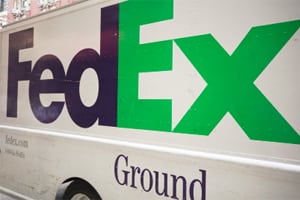 FedEx on Tuesday announced its rate change for 2015, increasing FedEx Ground, FedEx Express and FedEx Freight by 4.9%, effective January 5. This was a higher bump than in the past five years for FedEx Express, which had been going up 3.9% annually.
FedEx on Tuesday announced its rate change for 2015, increasing FedEx Ground, FedEx Express and FedEx Freight by 4.9%, effective January 5. This was a higher bump than in the past five years for FedEx Express, which had been going up 3.9% annually.
This is the first time FedEx has announced its ground rate change ahead of rival UPS. It was also out front in May, announcing that as of dimensional weight pricing will be applied to parcels measuring less than 3 cubic feet, which had been exempt, as of Jan. 1. UPS followed suit a month later, saying its change will take effect Dec. 29.
FedEx will release its first quarter earnings report today.
Using dimensional weight pricing or DIM, parcel shipping is priced based on a formula that takes into account volume as well as weight, a major change that will lead to higher costs for lighter items sent in larger boxes – a common scenario in ecommerce.
Jerry Hempstead, principal of operations consultant Hempstead Consulting, said the average rates put out by the major carriers were something of a misnomer as they’re calculated by adding up rates for parcels up to 70 pounds shipped from zones 1-8, then dividing by the total number of options. “The logic is that most shippers have equal distribution of shipments in each weight and zone, but that never happens,” Hempstead said. “Probably 80% of them are less than 20 pounds.”
In the past, FedEx would wait for UPS to announce its ground rates before following suit with rates that mirrored its larger rival. Hempstead said it’s not surprising that FedEx broke with tradition on its rate announcement, as it had already made its DIM rate changes public ahead of UPS.
“That was a leap for FedEx, going into new territory,” he said. “Had UPS not followed suit, they would have been in a tough position and might have been forced to backpedal. Then UPS made its DIM announcement a day before a FedEx earnings call. FedEx took that as a signal that they could announce ground rates first and hope UPS follows, but they may not care if they’re matched penny for penny, as has been the case for the past decade.”
While FedEx initially said its tariff sheet – which spells out the rate changes in detail – would be published in December, the sheet was made public as of today.
“What our clients and those with other consultants are going to come to us and say is, forget the average rate increase, what do these changes mean to my book of business?” Hempstead said.
Joe Bobko, principal of Bobko Consulting, said merchants should sit down with their shipping vendors and look at not only the impact of the rate changes but also DIM pricing to determine the impact on their business. He added he has seen a willingness on the part of both UPS and FedEx to work with shippers to mitigate the impact of DIM by negotiating custom divisors that lead to lower costs.
The way DIM pricing is calculated by both FedEx and UPS is by multiplying the length, width and height of a package, then dividing it by 166. Therefore, a higher the divisor means lower costs.
“For all the fear when DIM pricing came out a few months ago, at this point both carriers have shown they’re willing to mitigate the impact and thereby not lose business to the other guy,” Bobko said. “That’s been true not just with major shippers who have volumes above 10 million parcels per year, but smaller ones as well.”
